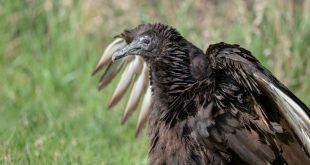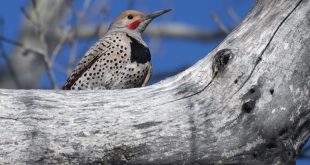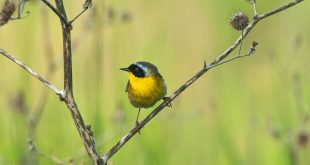The Harlan County Christmas Bird Count (CBC) took place 15 December and it set a record. Previous Harlan County CBC’s were held in consecutive years from 1996-2001 and the CBC resumed in 2014. Below, I provide a summary of the results from the 2016 edition of the Harlan County CBC.

Conditions: Weather was obviously cold ahead of the CBC. The lake was about 80% open, but all other water bodies, including the Republican River, were mostly or completely frozen. We also had a rather stiff south breeze on the day of the count that made birding conditions less than ideal. Temperatures ranged from 8 to 30 degrees Fahrenheit.
Species total: Eighteen observers tallied 90 species, which is a new record count. The previous record was 85 species recorded in 1998 and 1999. I also believe, based on a quick review, the Harlan County CBC is now only the second count in Nebraska to reach the 90 species pinnacle (the other is, of course, Lake McConaughy).
New CBC species: A whopping four species were recorded for the first time in 2016; Brewer’s Blackbird, an unidentified Calidris sandiper, Swamp Sparrow and Barred Owl are all new additions. Harlan County is at the western edge of the Barred Owl’s range in Nebraska and it has long been suspected there should be a few in the count circle. Owling efforts have unsuccessfully tried to detect this species, but the one found during the CBC was a bird flushed from its daytime roost. One party also reported a Pink-sided Junco, which is a new subspecies for the count.
Almost new CBC species: A Great-tailed Grackle was observed the day before the CBC, but missed the day of the count.
Other notable birds: Ruddy Duck (1), Common Loon (1), 6 species of gulls (including California, Thayer’s and Lesser Black-backed), Yellow-bellied Sapsucker (2), Red-breasted Nuthatch (2), Ruby-crowned Kinglet (1), Fox Sparrow (3), Rusty Blackbird (2) and Purple Finch (1).
Count Week birds: Species seen before the CBC, but not observed the day of the CBC include Wood Duck, Green-winged Teal, Killdeer, Golden Eagle and the aforementioned Great-tailed Grackle.
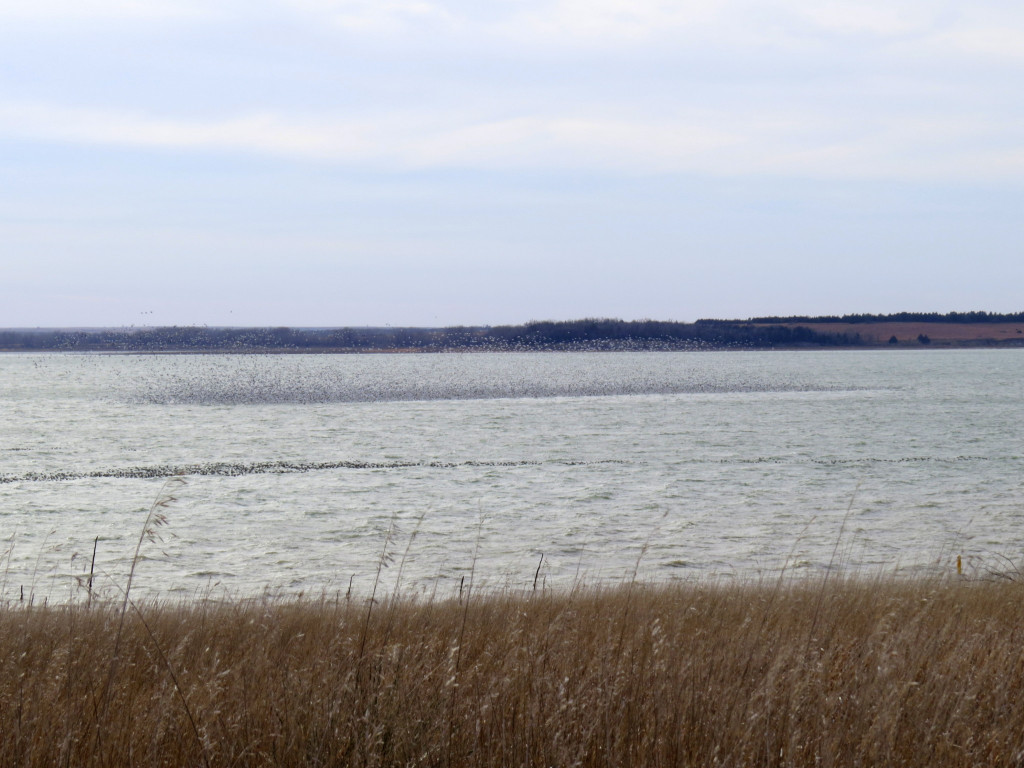
Record counts: Record counts of individual birds were the 62,370 Snow Geese (previous high count was 24,545 in 2015), an estimated 630 Ross’s Geese (33 in 1998), 21 Hooded Mergansers (14 in 2015), 117 Northern Bobwhite (16 in 1999), 3 Prairie Falcons (1, multiple years), 4 Carolina Wrens (3 in 1998 & 1999), 23 Yellow-rumped Warblers (17 in 1998 & 2001), 116 White-crowned Sparrows (114 in 1998). The estimate for Ross’s Geese was based on sampling of flocks that showed at least 1% of white geese were Ross’s Geese.
Bigest miss: Merlin has been recorded on seven of the eight previous CBCs.
Other misses: Great Blue Heron (recorded on 6/8 of the previous CBCs), Greater Prairie-Chicken (5/8), American White Pelican (4/8) and Winter Wren (4/8). Missing the heron was not a big surprise because of the recent cold weather and the iced over conditions of rivers and streams. Also, no grebes were found.
Biggest absence: As I did last year with this summary, I am making a distinction between a species present but not detected and one not present. During the first iteration (1996-2001), Black-billed Magpies were recorded every year (average number tallied was 24). In 2014, only 3 were found. None were found last year or this year, unfortunately. This species has been declining in Nebraska for over a decade and has disappeared from some areas and is on the verge of disappearing from other areas. The likely cause of the decline is West Nile Virus. Black-capped Chickadees were also hit hard by West Nile Virus. Their numbers also appear to be depressed compared to numbers encountered during the first iteration of the CBC. The graphic below illustrates this point for both species.
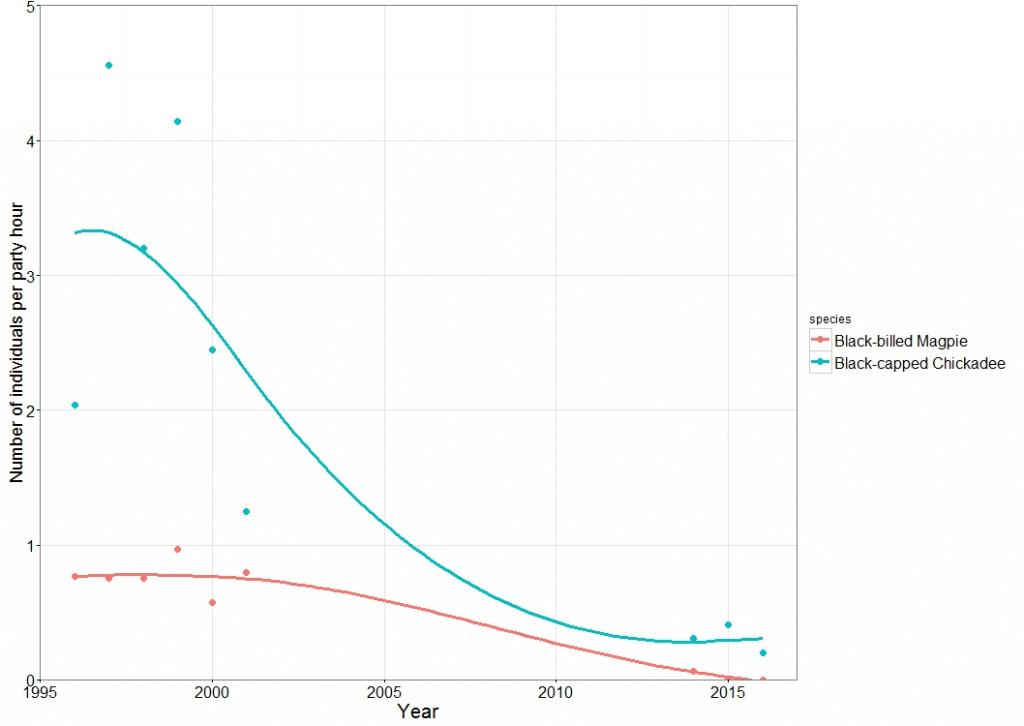
Sapsuckers continue to show well: Zero Yellow-bellied Sapsuckers were recorded during the first iteration (1996-2001) of the Harlan County CBC, but the species has been recorded on all three recent counts. Two sapsuckers were tallied in 2016.
Participants: Many thanks to individuals that braved snow and cold and did a great job counting birds. This year’s participants were: Mary Bomberger Brown, Clem Klaphake, Bette Klaphake, Lauren Dinan, Kenny Dinan, Larry Einemann, Andrew Furman, Robin Harding, Alice Heckman, Mallory Irvine, Joel Jorgensen, Richard Mathieson, Marty Mathieson, John Murphy, Lanny Randolph, Logan Shoup, Ross Silcock and T.J. Walker.

The overall species list is below.
Good birding!
The Harlan County Christmas Bird Count species list
Greater White-fronted Goose
Snow Goose
Ross’s Goose
Cackling Goose
Canada Goose
Wood Duck (CW)
Gadwall
American Wigeon
Mallard
Northern Shoveler
Northern Pintail
Green-winged Teal (CW)
Canvasback
Redhead
Ring-necked Duck
Lesser Scaup
Bufflehead
Common Goldeneye
Hooded Merganser
Common Merganser
Red-breasted Merganser
Ruddy Duck
Northern Bobwhite
Ring-necked Pheasant
Wild Turkey
Common Loon
Double-crested Cormorant
Bald Eagle
Northern Harrier
Sharp-shinned Hawk
Cooper’s Hawk
Red-tailed Hawk
Rough-legged Hawk
American Kestrel
Prairie Falcon
American Coot
Killdeer (CW)
Calidris spp.
Bonaparte’s Gull
Ring-billed Gull
California Gull
Thayer’s Gull
Herring Gull
Lesser Black-backed Gull
Rock Pigeon
Eurasian Collard-Dove
Mourning Dove
Eastern Screech-Owl
Great Horned Owl
Barred Owl
Belted Kingfisher
Red-bellied Woodpecker
Yellow-bellied Sapsucker
Downy Woodpecker
Hairy Woodpecker
Northern Flicker
Northern Shrike
Blue Jay
American Crow
Horned Lark
Black-capped Chickadee
White-breasted Nuthatch
Red-breasted Nuthatch
Brown Creeper
Carolina Wren
Golden-crowned Kinglet
Ruby-crowned Kinglet
Eastern Bluebird
American Robin
European Starling
Cedar Waxwing
Lapland Longspur
Yellow-rumped Warbler
Spotted Towhee
American Tree Sparrow
Fox Sparrow
Song Sparrow
Swamp Sparrow
Harris’s Sparrow
White-crowned Sparrow
Dark-eyed Junco
Northern Cardinal
Red-winged Blackbird
Rusty Blackbird
Brewer’s Blackbird
Brown-headed Cowbird
Common Grackle
Great-tailed Grackle (CW)
Meadowlark (sp.)
Purple Finch
House Finch
Pine Siskin
American Goldfinch
House Sparrow
 Nebraskaland Magazine
Nebraskaland Magazine

